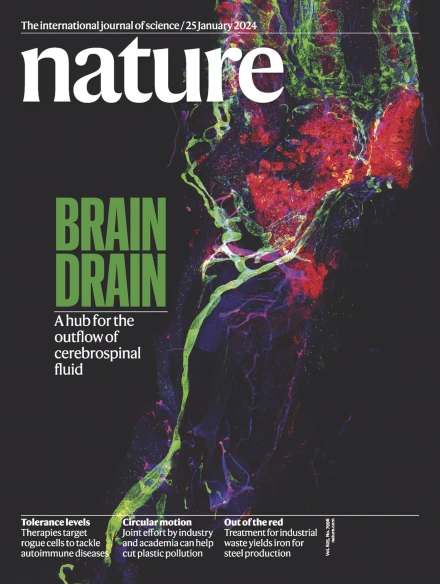糖胺聚糖驱动的脂蛋白摄取保护肿瘤免于铁下垂
IF 48.5
1区 综合性期刊
Q1 MULTIDISCIPLINARY SCIENCES
引用次数: 0
摘要
由于其结构和信号作用,脂质是癌细胞的重要组成部分。为了满足代谢需求,许多癌症需要细胞外脂质2,3,4,5;然而,这些脂质如何促进癌症的生长和进展仍然知之甚少。在这里,使用功能遗传筛选,我们确定脂蛋白的摄取-循环中脂质转运的主要机制-是癌症中铁中毒敏感性的关键决定因素。补充脂蛋白主要通过α-生育酚(α-toc)——人类脂蛋白中最丰富的维生素E形式——的传递,强有力地抑制了多种癌症类型的铁下垂。从机制上讲,癌细胞摄取脂蛋白的途径依赖于与细胞表面蛋白聚糖相连的硫酸糖胺聚糖(GAGs)。破坏GAG生物合成或急性降解表面GAG可减少脂蛋白摄取,使癌细胞对铁下垂敏感,并损害小鼠肿瘤生长。值得注意的是,与正常肾组织相比,人透明细胞肾细胞癌(一种富含脂质的恶性肿瘤)表现出硫酸软骨素水平升高和脂蛋白衍生α-toc水平升高。总之,我们的研究确定了脂蛋白摄取是癌症中一个关键的抗铁的机制,并暗示了GAG生物合成是一个治疗靶点。本文章由计算机程序翻译,如有差异,请以英文原文为准。


Glycosaminoglycan-driven lipoprotein uptake protects tumours from ferroptosis
Lipids are essential components of cancer cells due to their structural and signalling roles1. To meet metabolic demands, many cancers take up extracellular lipids2–5; however, how these lipids contribute to cancer growth and progression remains poorly understood. Here, using functional genetic screens, we identify uptake of lipoproteins—the primary mechanism for lipid transport in circulation—as a key determinant of ferroptosis sensitivity in cancer. Lipoprotein supplementation robustly inhibits ferroptosis across diverse cancer types, primarily through the delivery of α-tocopherol (α-toc), the most abundant form of vitamin E in human lipoproteins. Mechanistically, cancer cells take up lipoproteins through a pathway dependent on sulfated glycosaminoglycans (GAGs) linked to cell-surface proteoglycans. Disrupting GAG biosynthesis or acutely degrading surface GAGs reduces lipoprotein uptake, sensitizes cancer cells to ferroptosis and impairs tumour growth in mice. Notably, human clear cell renal cell carcinomas—a lipid-rich malignancy—exhibit elevated levels of chondroitin sulfate and increased lipoprotein-derived α-toc compared with normal kidney tissue. Together, our study establishes lipoprotein uptake as a critical anti-ferroptotic mechanism in cancer and implicates GAG biosynthesis as a therapeutic target. Lipoprotein uptake dependent on sulfated glycosaminoglycans linked to cell-surface proteoglycans is a key determinant of ferroptosis sensitivity in cancer.
求助全文
通过发布文献求助,成功后即可免费获取论文全文。
去求助
来源期刊

Nature
综合性期刊-综合性期刊
CiteScore
90.00
自引率
1.20%
发文量
3652
审稿时长
3 months
期刊介绍:
Nature is a prestigious international journal that publishes peer-reviewed research in various scientific and technological fields. The selection of articles is based on criteria such as originality, importance, interdisciplinary relevance, timeliness, accessibility, elegance, and surprising conclusions. In addition to showcasing significant scientific advances, Nature delivers rapid, authoritative, insightful news, and interpretation of current and upcoming trends impacting science, scientists, and the broader public. The journal serves a dual purpose: firstly, to promptly share noteworthy scientific advances and foster discussions among scientists, and secondly, to ensure the swift dissemination of scientific results globally, emphasizing their significance for knowledge, culture, and daily life.
 求助内容:
求助内容: 应助结果提醒方式:
应助结果提醒方式:


